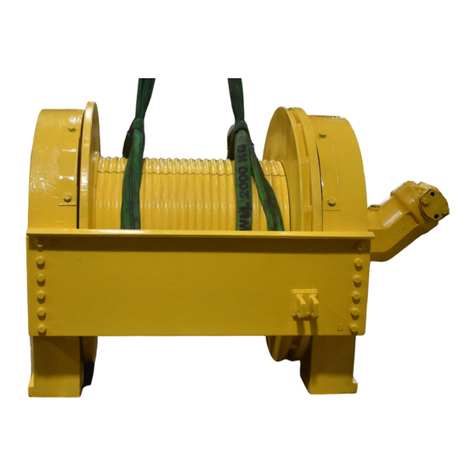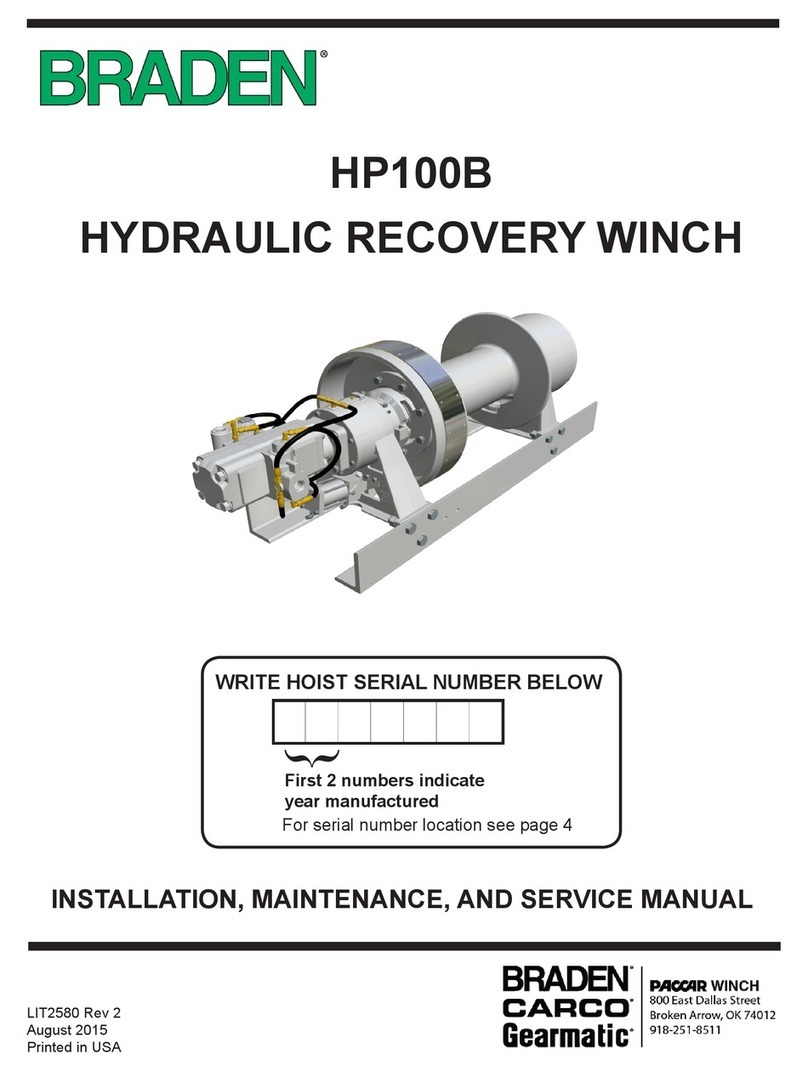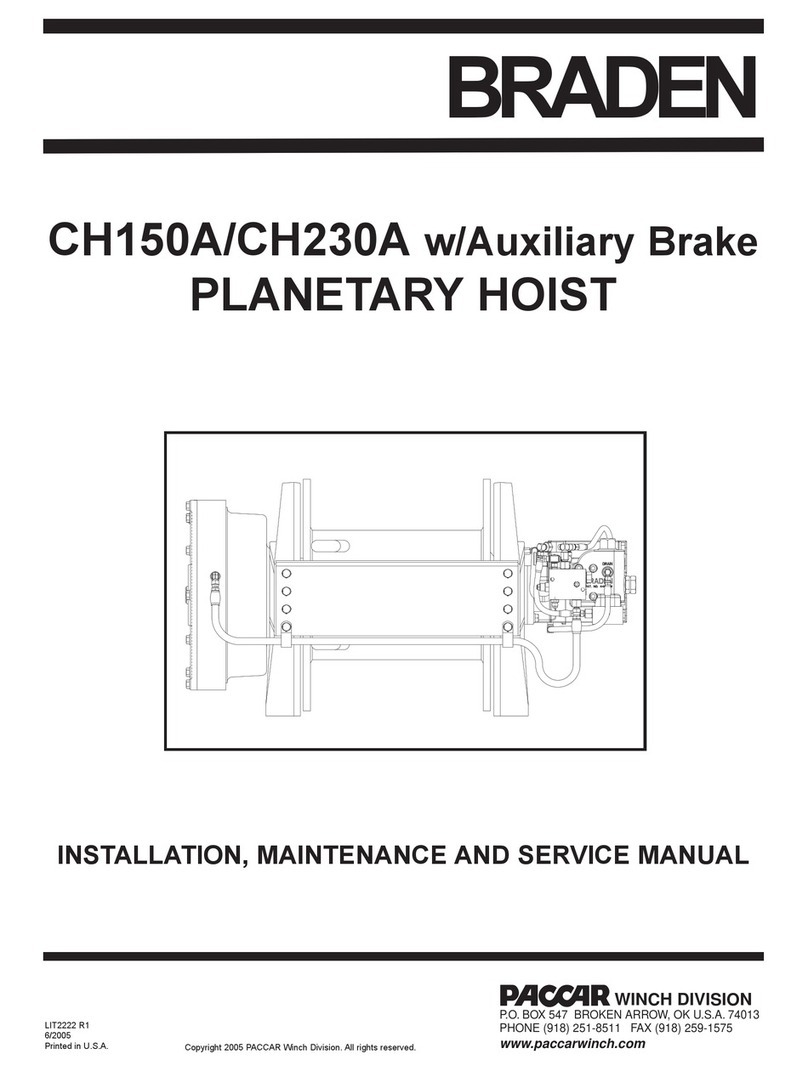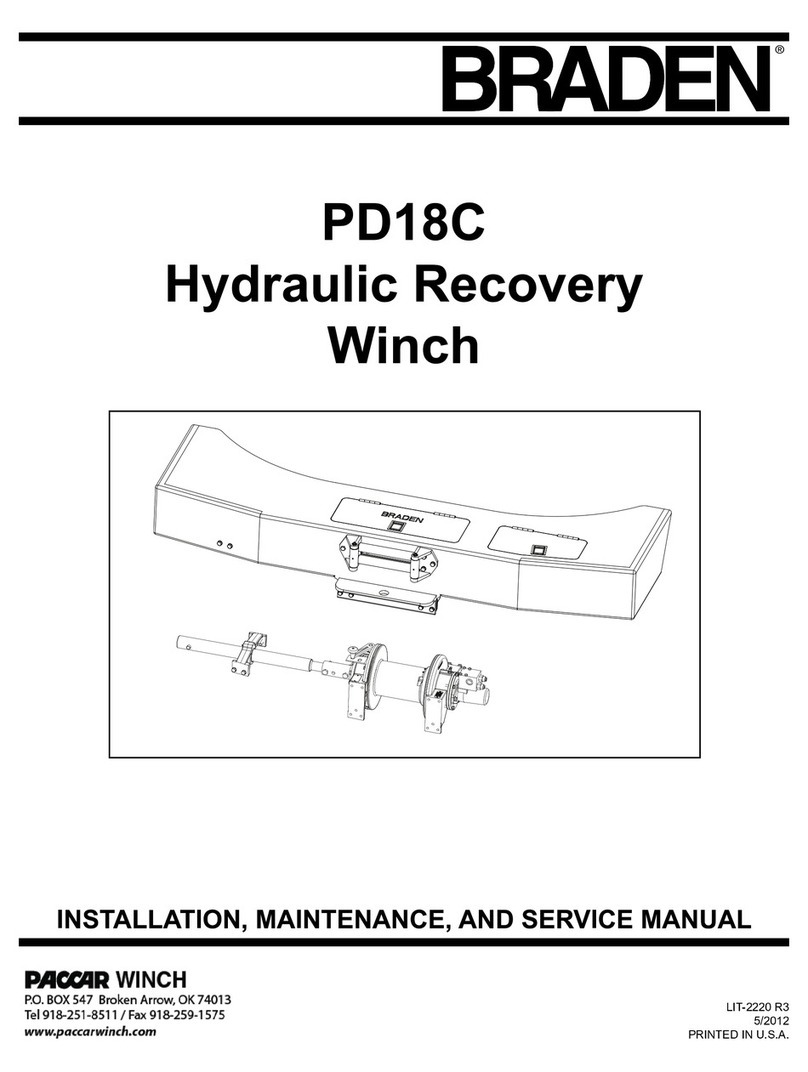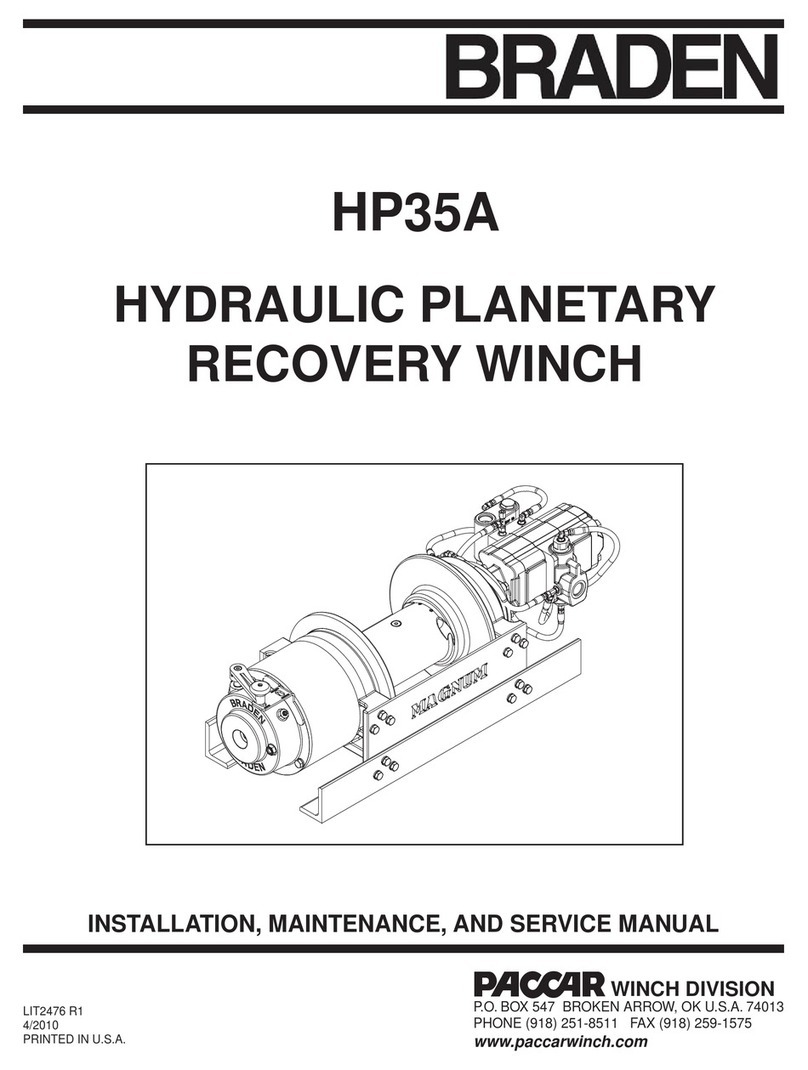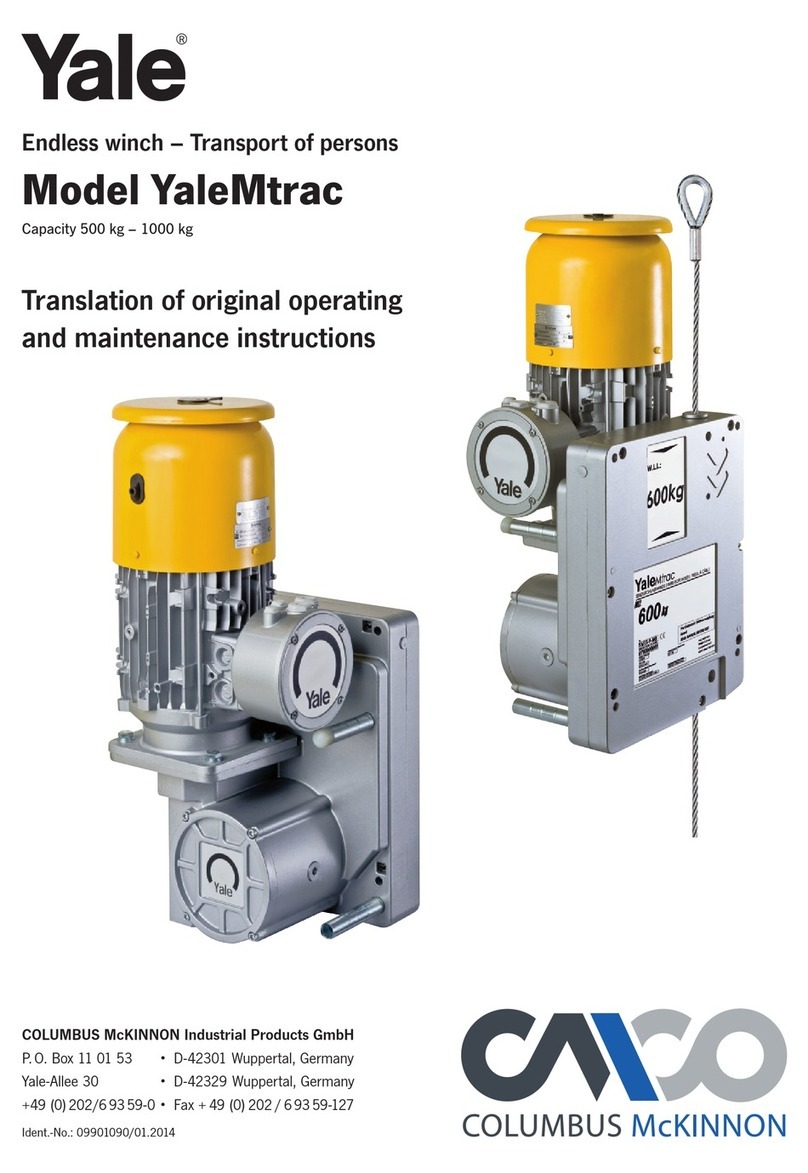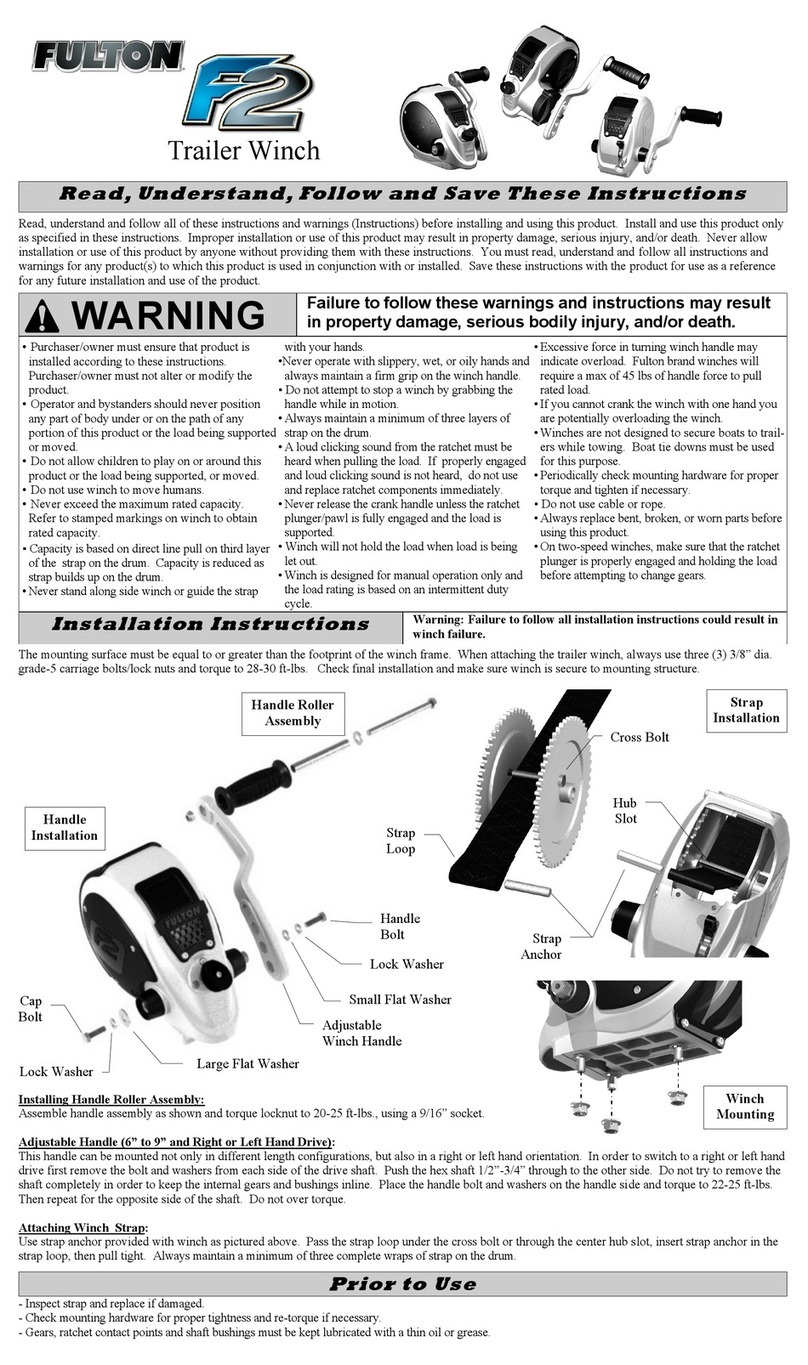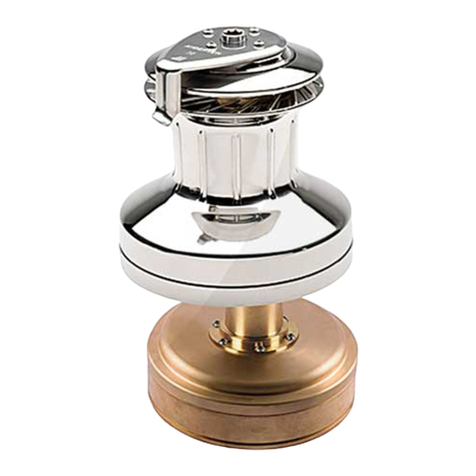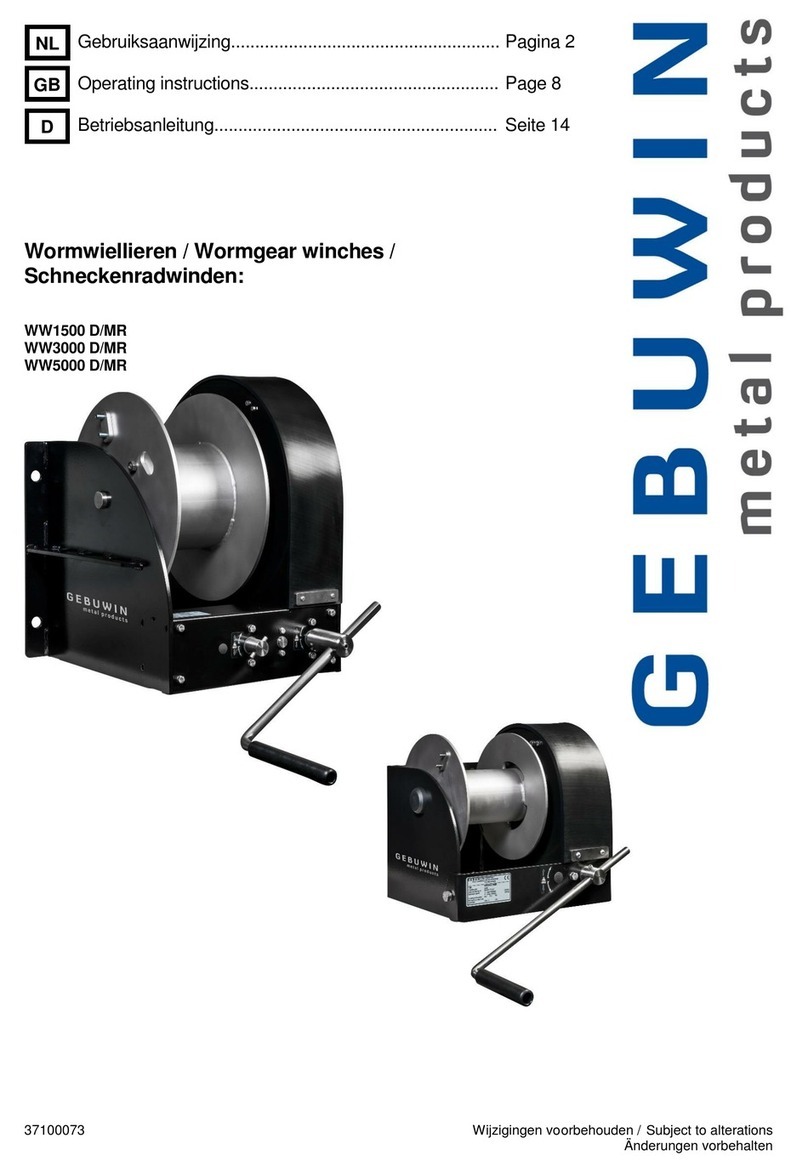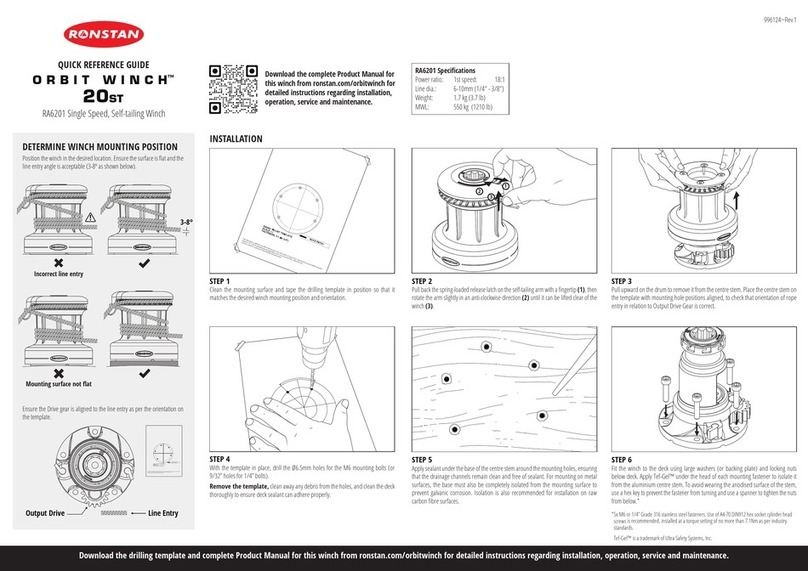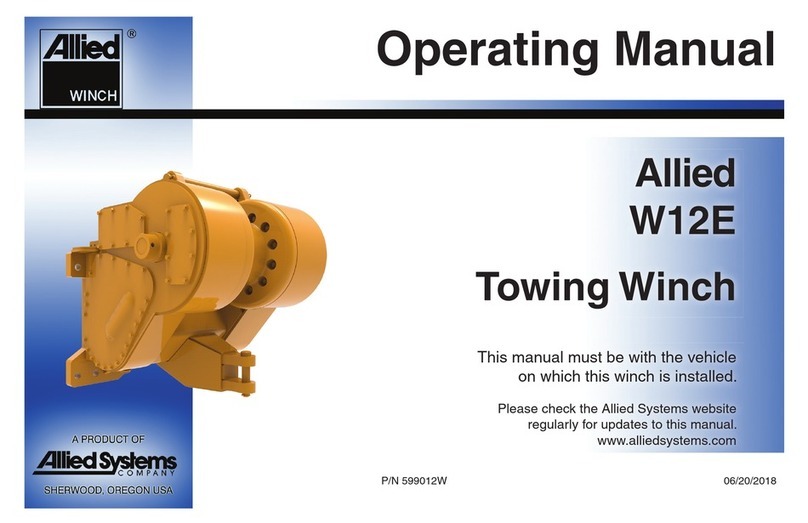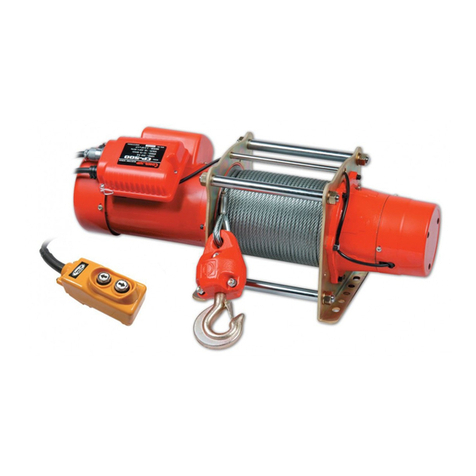BRADEN PD12C Series Manual

1
SERIES
PD12C
PD15B
PD17A HYDRAULIC HOIST
LIT2103 R4
07-2013
PRINTED IN U.S.A.
P.O. BOX 547 Broken Arrow, OK 74013
Tel 918-251-8511 / Fax 918-259-1575
www.paccarwinch.com
WINCH
INSTALLATION, MAINTENANCE, AND SERVICE MANUAL
X-rigs
model
PD12C-SPL-59034-02L-1

2
Table of Contents
GENERAL SAFETY RECOMMENDATIONS ................................................................4
THEORY OF OPERATION............................................................................................5
HOIST INSTALLATION..................................................................................................7
RECOMMENDED FASTENER TORQUE.....................................................................9
WIRE AND BRAIDED ROPE INSTALLATION ..............................................................9
TWO SPEED MOTOR CASE DRAIN PLUMBING......................................................10
PREVENTIVE MAINTENANCE...................................................................................10
RECOMMENDED OIL CHANGE INFORMATION.......................................................11
TROUBLE SHOOTING ...............................................................................................12
HOIST DISASSEMBLY................................................................................................16
EXPLODED VIEW DRAWING AND PARTS KEY..................................................18-19
PLANET CARRIER SERVICE.....................................................................................20
MOTOR SUPPORT – BRAKE CYLINDER SERVICE.................................................22
BRAKE CLUTCH SERVICE........................................................................................26
HOISTASSEMBLY......................................................................................................28
BRAKE VALVE SERVICE............................................................................................32
REVERSING DIRECTION OF DRUM ROTATION......................................................34
PD17A ROTATION INDICATION PROXIMITY SENSOR............................................36

3
FOREWORD
Read this entire publication and retain it for future reference.
If you have any questions regarding your Braden Planetary Hoist or this publication, call the Braden Service Depart-
ment at 1-918-251-8511, 08:00-1630 hours, CT, Monday through Friday.
The minimum service intervals specified are for operating hours of the prime mover.
The following service instructions have been prepared to provide assembly, disassembly and maintenance informa-
tion for the BRADEN Model PD12C, PD15B and PD17A series hoist. It is suggested that before doing any work on
these units, all assembly and disassembly instructions should be read and understood.
Some pictures in this manual may show details or attachments that are different from your hoist.Also, some compo-
nents have been removed for illustrative purposes. Illustrations and pictures in this manual are of a “typical” unit sold
through our distribution channels. Some hoists, particularly those sold directly to original equipment manufacturers
(OEM), may differ in appearance and options.
Whenever a question arises regarding your BRADEN HOIST, please contact BRADEN Service Department for the
latest available information.
Serial Numbers and Model Numbers are located to
the left hand side of the hydraulic motor, stamped
into the base.Always refer to the Serial Number and
Model Number when requesting information or ser-
vice parts.
PD DESIGNATES POWER DRUM
12 DESIGNATES 12,000 LB. APPROXIMATE FIRST LAYER LINE PULL
C DESIGNATES THE MODEL SERIES RELATING TO DESIGN CHANGES
29 DESIGNATES TOTAL GEAR REDUCTION (OTHER RATIOS INCLUDE 21, 41, 59, 34, ETC.)
064 DESIGNATES HYDRAULIC MOTOR DISPLACEMENT IN CU. IN/REV
(DECIMAL POINT ELIMINATED. EXAMPLE 064 = 6.4 CU IN/REV)
02 DESIGNATES THE DRUM OPTION (OTHER DRUMS INCLUDE 01, 04, 05, 23G, ETC.)
U DESIGNATES UNDERWOUND CABLE DRUM - OPTIONAL
L DESIGNATES LEFT HAND BASE - OPTIONAL, BLANK IS STANDARD RIGHT HAND BASE
1 PERMITS TESTINGAND INSPECTION PERAPI 2C FOR OFFSHORE CRANES - OPTIONAL
EXPLANATION OF MODEL NUMBER
PD 12 C 29 064 - 02 - U - L - 1
POWER
DRUM MAX
RATING DESIGN
SERIES GEAR
RATIO MOTOR
SIZE DRUM
OPTION OPTIONROTATION BASE

4
CAUTION – This emblem is used to warn against
potential or unsafe practices which COULD result
in personal injury and product or property damage if
proper procedures are not followed.
GENERAL SAFETY RECOMMENDATIONS
Safety and informational callouts used in this manual include:
WARNING – This emblem is used to warn against
hazards and unsafe practice which COULD result in
severe personal injury or death if proper procedures
are not followed.
CAUTION
!
!
!WARNING !
Safety for operators and ground personnel is of prime concern. Always take the necessary precautions to ensure
safety to others as well as yourself. To ensure safety, the prime mover and hoist must be operated with care and
concern by the operator for the equipment and a thorough knowledge of the machine’s performance capabilities.
The following recommendations are offered as a general safety guide. Local rules and regulations will also apply.
1. Be certain equipment (boom, sheave blocks,
pendants, etc.) is either lowered to the ground or
blocked securely before servicing, adjusting, or re-
pairing hoist.
2. Be sure personnel are clear of work area BEFORE
operating hoist.
3. Read all warning and caution tag information pro-
vided for safe operation and service of hoist.
4. Inspect rigging and hoist at the beginning of each
work shift. Defects should be corrected immediately.
5. Keep equipment in good operating condition. Per-
form scheduled servicing and adjustments listed in
the “Preventive Maintenance” section of this manu-
al.
6. An equipment warm-up procedure is recommended
for all start-ups and essential at ambient tempera-
tures below +40°F (4°C). Refer to “Warm-up Proce-
dure” listed in the “Preventive Maintenance” section
of this manual.
7. Operate hoist line speeds to match job conditions.
8. Leather gloves should be used when handling wire
rope.
9. Never attempt to handle wire rope when the hook
end is not free. Keep all parts of body and clothing
clear of cable rollers, cable entry area of fairleads
and hoist drum.
10. When winding wire rope on the hoist drum, never
attempt to maintain tension by allowing wire rope to
slip through hands. Always use “Hand-Over-Hand”
technique.
11. Never use wire rope with broken strands. Replace
wire rope.
12.Do not weld on any part of the hoist.
13.Use recommended hydraulic oil and gear lubricant.
14.Keep hydraulic system clean and free from contami-
nation at all times.
15.Use correct anchor for wire rope and pocket in
drum.
16.Do not use knots to secure or attach wire rope.
17.The BRADEN designed wire rope anchors are ca-
pable of supporting the rated load when installed
properly. For additional safety, ALWAYS maintain a
minimum of five (5) wraps of wire rope on the drum.
18.Never attempt to clean, oil or perform any mainte-
nance on a machine with the engine or prime mover
running, unless instructed to do so in this manual.
19.Never operate hoist controls unless you are prop-
erly positioned at the operators station and you are
sure personnel are clear of the work area.
20.Assure that personnel who are responsible for hand
signals are clearly visible and that the signals to be
used are thoroughly understood by everyone.
21.Ground personnel should stay in view of the opera-
tor and clear of hoist drum. Do not allow ground per-
sonnel near hoist line under tension.Asafe distance
of at least 1-1/2 times the length of the cable should
be maintained.
22.Do not exceed the maximum pressure, PSI (kPa),
or flow, GPM (LPM), stated in the hoist specifica-
tions.
23.Install guarding to prevent personnel from get-
ting any part of body or clothing caught at a point
where the cable is wrapped onto the drum or drawn
through guide rollers.
24.“Deadman” controls, which automatically shut off
power to the hoist whenever the operator leaves his
station, should be installed whenever practicable.
25.Never allow anyone to stand under a suspended
load.
26.Avoid sudden “shock” loads or attempting to “jerk”
load free. This type of operation may cause heavy
loads, in excess of rated capacity, which may result
in failure of cable and hoist.

5
DESCRIPTION OF HOIST
The hoist has four basic component parts:
1. Hoist base
2. Hydraulic motor and brake valve
3. Brake cylinder and motor support
4. Drum assembly
The drum assembly consists of three basic assem-
blies:
1. Drum with integral ring gear
2. Output planetary gear set
3. Primary planetary gear set
Thehydraulicmotoris boltedtothemotor support which
in turn is bolted to the brake cylinder and the base. The
motor end of the drum, running on a ball bearing, is
supported by the brake cylinder. The other end of the
drum runs on a ball bearing on the support bolted to the
base. The ring gear for both planetary sets is machined
into the drum’s inside surface.
HOIST OPERATION
The hydraulic motor drives the sun gear of the primary
planetary gear set through the splined inner race of the
overrunning brake clutch. When driven by the sun gear,
the primary planet gears walk around the ring gear in
the drum and drive the primary planet carrier.
The primary planet carrier drives the output planet
sun gear which, in turn drives the output planet gears.
The output planet carrier is splined to the bearing sup-
port and cannot rotate. Therefore, as the output planet
gears are driven by the sun gear, they will drive the ring
gear/drum.
DUAL BRAKE SYSTEM - DESCRIPTION
The dual brake system consists of a dynamic brake
system and a static brake system.
The dynamic brake system has two operating compo-
nents:
1. Brake valve assembly
2. Hydraulic motor
The brake valve is basically a counterbalance valve
with good metering characteristics. It contains a check
valve to allow free flow of oil to the motor in the hoist-
ing direction and a pilot operated, spring-loaded spool
valve that blocks the flow of oil out of the motor when
the control valve is placed in neutral. When the control
valve is placed in the lowering position, the spool valve
remains closed until sufficient pilot pressure is applied
to the end of the spool to shift it against spring pres-
sure and open a passage. After the spool valve cracks
open, the pilot pressure becomes flow-dependent and
modulates the spool valve opening which controls the
lowering speed. Refer to figures 1, 2, and 3.
Figures 1, 2, and 3.
THEORY OF OPERATION
The static brake system has three operating compo-
nents:
1. Spring Applied, Multiple Friction Disc Static Brake
2. Overrunning Brake Clutch Assembly
3. Hydraulic Piston and Cylinder
Motor
Control Valve
Pump
To Tank
Brake Valve
Static Brake
Medium
Pressure
Low
Pressure
High
Pressure
Figure 1
HOISTING
Motor
Control Valve
Pump
To Tank
Brake Valve
Static Brake
Medium
Pressure
Low
Pressure
High
Pressure
Figure 2
LOWERING 1

6
Motor
Control Valve
Pump
To Tank
Brake Valve
Static Brake
Medium
Pressure
Low
Pressure
High
Pressure
Figure 3
LOWERING 2
The static brake is released by the brake valve pilot
pressure at a pressure lower than that required to open
the pilot operated spool valve. This sequence assures
that dynamic braking takes place in the brake valve and
that little, if any, heat is absorbed by the friction brake.
The friction brake is a load holding brake only and has
nothing to do with dynamic braking or rate of descent
of a load.
The overrunning brake clutch is splined to the primary
sun gear shaft between the motor and the primary sun
gear. It will allow this shaft to turn freely in the direction
to raise a load and lock up to force the brake discs to
turn with the shaft in the direction to lower a load. Refer
to figures 4 and 5.
The hydraulic cylinder, when pressurized, will release
the spring pressure on the brake discs, allowing the
brake discs to turn freely.
Dual Brake System – Operation
When hoisting a load, the brake clutch which connects
the motor shaft to the primary sun gear, allows free rota-
tion. The sprag cams lay over and permit the inner race
to turn free of the outer race. Figure 4. The friction brake
remains fully engaged. The hoist, in raising a load, is
not affected by any braking action. Figure 1.
When the lifting operation is stopped, the load attempts
to turn the primary sun gear in the opposite direction.
This reversed input causes the sprag cams to instantly
roll upward and firmly lock the shaft to the fully engaged
friction brake. Figure 5.
When the hoist is powered in reverse, to lower the load,
the motor cannot rotate until sufficient pilot pressure is
present to open the brake valve. Figures 2 & 3. The
friction brake within the hoist will completely release at
a pressure lower than that required to open the brake
valve. The extent to which the brake valve opens will
determine the amount of oil that can flow through it and
the speed at which the load will be lowered. Increas-
ing the flow of oil to the motor will cause the pressure
to rise and the opening in the brake valve to enlarge,
speeding up the descent of the load. Decreasing this
flow causes the pressure to lower and the opening in
the brake valve to decrease thus slowing the descent
of the load.
When the control valve is shifted to neutral, the pres-
sure will drop and the brake valve will close, stopping
the load. The friction brake will engage and hold the
load after the brake valve has closed.
When lowering a load very slowly for precise position-
ing, no oil flow actually occurs through the hoist motor.
The pressure will build up to a point where the brake will
release sufficiently to allow the load to rotate the motor
through its own internal leakage. This feature results in
a very slow speed and extremely accurate positioning.
The friction brake receives very little wear in the lower-
ing operation. All of the heat generated by the lowering
and stopping of a load is absorbed by the hydraulic oil
where it can be readily dissipated.
Sprag Cams
Static Friction Brake Applied
Permits free shaft rotation
while hoisting
Sprag Cams
Static Friction Brake Applied
Load attempts to rotate shaft in opposite direction
Brake clutch locks sun gear shaft to friction brake
Figure 4
Figure 5

7
HOIST INSTALLATION
1. The hoist should be mounted with the centerline
of the drum in a horizontal position. The mounting
plane of the base may be rotated in any position
around this centerline.
2. Because of the design of the mounting base, the
direction of line pull should only be as shown in the
above illustration. Line pulls in any other direction
must be approved by BRADEN Engineering.
3. When mounting the hoist, use all eight (8) mounting
holes and grade 8 capscrews and nuts. Tighten to
recommended torque.
It is important that the hoist is mounted on a surface
that will not flex when in use, and cause binding of
the gear train. Binding in the gear train will result in
accelerated wear and heat. Also, be sure the hoist
is mounted on a flat surface. If necessary, use shim
stock to insure the mounting surface is flat within
0.020 in. (0.5 mm). Use stainless steel shim stock
as required.
4. The vent plug must always be located above the
horizontal centerline. If the hoist is mounted on a
pivoting surface, be sure vent plug remains above
the centerline in all positions. If necessary, reposi-
tion bearing support and vent plug as follows:
A. Remove bearing support bolts.
B. Rotate bearing support until vent plug
is positioned correctly and bolt holes
are aligned.
C. Evenly tighten bolts to recommended
torque.
5. Hydraulic lines and components that operate the
hoist must be of sufficient size to assure minimum
back-pressure at the hoist motor ports. The hydrau-
lic back-pressure measured at the motor work ports
must be less than 100 PSI (690 kPa) at full operating
flow. Back-pressure in excess of 100 PSI (690 kPa)
will shorten motor shaft seal life and partially release
the load holding brake. The standard hoist is sup-
plied with the gear motor internally drained and con-
nected the drain by-pass port on the Braden brake
valve. If high back-pressures are encountered, the
motor should be externally drained directly to the
reservoir and the “DRAIN” port on the brake valve
capped. All piston motors MUST be drained directly
to the reservoir. The piston motor case drain port
must NEVER be exposed to more than 42 PSI (290
kPa); shaft seal damage will occur.
6. The hoist should be mounted perpendicular to an
imaginary line from the center of the drum to the first
sheave to insure even spooling. Make certain the
fleet angle does not exceed 1-1/2 degrees.
TO LOAD
OR
FIRST SHEAVE
A = B
A
B
1/2 MIN
1 1/2 MAX
O
O
FLEET ANGLE
CenterLine
VENT PLUG
ABOVE CENTERLINE
This hoist m er
SIONS
BROKE 4012
U.S.A.
SERIAL NO. 76381
BRADEN Gearmatic
HOIST
BRADEN Gearmatic Service Manual.
76381
SERIAL NO.
U.S.A.
BROKEN ARROW,OK.,74012
WINCH DIVISIONS
This hoist must be maintained per
HOIST

8
The directional control valve must be a three po-
sition, four- way valve without detents and with a
spring centered motor spool such that the valve re-
turns to the centered position whenever the handle
is released, and both work ports are open to tank
(open center, open port).
7. High quality hydraulic oil is essential for satisfactory
performance and long hydraulic system component
life.
HOIST BRAKE
BRAKE
VALVE
PUMP
CONTROL
VALVE
HOIST ASSEMBLY
W/BRAKE VALVE
& STATIC BRAKE
BR
DR
DO NOT use a control valve with any detents or
latching mechanism that would hold the control valve
in an actuated or running position when the operator
releases the control handle. Use of the wrong type
of control valve could lead to unintentional operation
of the hoist, which could result in property damage,
personal injury, or death.
WINCH BRAKE
BRAKE
VALVE
2-SPEED
SELECTOR
VALVE
PUMP
CONTROL
VALVE
WINCH ASSEMBLY
W/BRAKE VALVE
& STATIC BRAKE
TP
BR
DR
A
Oil having 150 to 330 SUS (30-60 cSt) viscosity at
104°F (40°C) and viscosity index of 100 or greater
will give good results under normal temperature
conditions. The use of an oil having a high viscosity
index will minimize cold-start trouble and reduce the
length of warm-up periods. A high viscosity index
will minimize changes in viscosity with correspond-
ing changes in temperature.
Maximum cold weather start-up viscosity should not
exceed 5000 SUS (1000 cSt) with a pour point at
least 20°F (11°C) lower than the minimum tempera-
ture.
Under continuous operating conditions the tempera-
ture of the oil at any point in the system must not
exceed 180°F (82°C). Optimum oil temperature is
generally considered to be 120-140°F (49-60°C).
In general terms; for continuous operation at am-
bient temperatures between 50 and 110°F (10 to
43°C) use ISO 46; for continuous operation between
10 and 90°F (-12 to 32°C) use ISO 32; for applica-
tions colder than 10°F (-12°C), contact the BRADEN
Service Department. The use of multi-viscosity oils
is generally not recommended.
8. The hydraulic oil filter should have a 10 micron nom-
inal rating and be full flow type and meet the require-
ments of the hydraulic pump manufacturer.

9
ANCHORING BRAIDED ROPEANCHORING WIRE ROPE
RECOMMENDED FASTENER TORQUE
Higher or lower torques for special applications will be specified such as the use of spanner nuts, nuts on shaft
ends, jam nuts and where distortion of parts or gaskets is critical.
Lubricated torque values based on use of SAE 30wt engine oil applied to threads and face of bolt or nut.
Avoid using thread lubricants (such as anti-seize compound) as the applied torque may vary by 10 - 40%, de-
pending upon the product used.
7RUTXH/%)71P 7RUTXH/%)71P
%ROW
'LDP
,QFKHV
7KUHDG
SHU
LQFK
*UDGH *UDGH %ROW
'LDP
,QFKHV
7KUHDG
SHU
LQFK
*UDGH *UDGH
'U\ /XEHG 'U\ /XEHG 'U\ /XEHG 'U\ /XEHG
7RFRQYHUW/%)7WR.
J
PPXOWL
S
O
\
/%)7YDOXHE
\
WIRE AND BRAIDED ROPE INSTALLATION
Take the free end of the wire rope and insert it through
the small opening of the anchor pocket. Loop the wire
rope and push the free end about half of the way back
throughthepocket.Installthe wedge, thenpull the slack
out of the wire rope. The wedge will slip into the pocket
and secure the wire rope into the drum. The early style
anchor wedge is designed to accommodate several dif-
ferent sizes of wire rope. You may anchor 7/16 and 1/2
in. (11 & 13 mm) wire rope by inserting the wedge, large
end first. Anchor 9/16 and 5/8 in. (14 & 16 mm) wire
rope by inserting the wedge, small end first.
Early Style
Wire Rope
Anchor
A special wedge is used to anchor 1 and 1 1/8 in. (25
& 28 m) braided synthetic rope. The installation proce-
dure is the same as for anchoring wire rope.
CORRECT INSTALLATION INCORRECT INSTALLATION
Figure 7 Figure 8 Figure 9 Figure 10
Drive from
this side
Wedge and wire
rope fully seated
in pocket
Wedge not
fully Seated Wedge pulled
too far through
anchor pocket

10
The following minimum service intervals are speci-
fied for operating hours of the prime mover.
TWO SPEED MOTOR CASE DRAIN PLUMBING
Some hoists with two speed gear motors may have
been installed with the motor case drain connected to
the drain port of the brake valve. This system may result
in accelerated motor shaft seal wear and leakage. The
following modification should be made to the motor hy-
draulic piping to prevent this type of seal damage.
1. Remove the motor case drain hose from the
brake valve drain port and install plug, Item
1, into the valve port. Remove the hose from
the case drain port elbow, Item 4.
2. Install a new case drain hose, Item 2, onto
the motor case drain elbow, Item 4.
3. Install the tee adapter, Item 3, into the two-
speed motor shift valve drain port (identified
by long end cap).
4. Install the new motor case drain hose, Item
2, onto the tee adapter.
5. Install a case drain hose for the tee directly
to the reservoir. Minimum hose size is –6,
3/8 in. (9.5 mm). Maximum drain line back
pressure is 100 PSI (690 kPa) measured at
the motor case drain port.
ITEM DESCRIPTION QTY PART #
1 Plug, -4 ORB 1 25663
2Hose, 17-in. OAL
(-4 JIC Fml Svl/-4 Hose/ 1/8 NPT ml) 1 13707
3 Tee -4 (ORB Branch -4 JIC Run) 1 29078
1
2
3
PREVENTIVE MAINTENANCE
A regular program of preventive maintenance for your planetary hoist is strongly recommended to minimize the
need for emergency servicing and promote safe, reliable hoist operation.
Field experience, supported by engineering tests, indicate the three (3) service procedures listed below are the
MOST critical to safe, reliable hoist operation and must be observed.
• Regular Gear Oil Changes – every 1000 hours or six (6) months
• Use of Proper Gear Oil – recommended type for prevailing ambient temperature
• Periodic disassembly and inspection of all wear items.
1. OIL LEVEL
The gear oil level should be checked every 500
operating hours or three (3) months, whichever occurs
first. To check the oil level, remove the large plug locat-
ed in the center of the drum support. The oil should be
level with the bottom of this opening or approximately
half-way up in a sight glass. This is extremely impor-
tant due to the accelerated wear that can be caused
by insufficient lubricating oil in the hoist. If addi-
tional oil in needed, refer to “Recommended Planetary
Gear Oil”.

11
2. OIL CHANGE
The gear oil should be changed after the first
one hundred (100) hours of operation, then every 1,000
operating hours or six (6) months, whichever occurs
first. The gear oil must be changed to remove wear
particles that impede the reliable and safe operation of
the brake clutch and erode bearings, gears and seals.
Failure to change gear oil at these suggested minimum
intervals may contribute to intermittent brake slippage
which could result in property damage, severe personal
injury or death.
The gear oil should also be changed whenever
the ambient temperature changes significantly and an
oil from a different temperature range would be more
appropriate. Oil viscosity with regard to ambient tem-
perature is critical to reliable brake clutch operation.
Our tests indicate that excessively heavy or thick gear
oil may contribute to intermittent brake clutch slippage.
Make certain that the gear oil viscosity used in your
hoist is correct for your prevailing ambient temperature.
Failure to use the proper type and viscosity of planetary
gear oil may contribute to brake clutch slippage which
could result in property damage, severe personal injury
or death. Refer to “Recommended Planetary Gear Oil”
for additional information.
3. VENT PLUG
The vent plug is located in the drum support as
shown. It is very important to keep this vent clean and
unobstructed. Whenever gear oil is changed, remove
vent plug, clean in solvent and reinstall.
Do not paint over the vent or replace with a solid plug.
4. HYDRAULIC SYSTEM
The original filter element should be replaced
after the first fifty (50) hours of operation, then every
500 operating hours or three (3) months, or in accor-
dance with the equipment manufacturer’s recommen-
dations.
5. WIRE ROPE
Inspect entire length of wire rope according to
wire rope manufacturers recommendations.
6. MOUNTING BOLTS
Tighten all hoist base mounting bolts to recom-
mended torque after the first one hundred (100) hours
of operation, then every 1000 operating hours or six (6)
months, whichever occurs first.
7. WARM-UP PROCEDURES
Awarm-up procedure is recommended at each
start-up and is essential at ambient temperatures below
+40°F (4°C).
The prime mover should be run at its lowest
recommended RPM with the hydraulic hoist control
valve in neutral allowing sufficient time to warm up
the system. The hoist should then be operated at low
speeds, raise and lower, several times to prime all lines
with warm hydraulic oil, and to circulate gear lubricant
through the planetary gear sets.
8. INSPECTION
A. Bearings and Gears – Refer to
DISASSEMBLY OF Hoist, page 15; and
PLANET CARRIER SERVICE, page 20.
B. Brake Cylinder – Refer to MOTOR
SUPPORT – BRAKE CYLINDER SERVICE,
pages 22 and 23.
C. Brake Clutch – Refer to BRAKE CLUTCH
SERVICE, page 26.
Failure to properly warm up the hoist, particularly un-
der low ambient temperature conditions, may result
in temporary brake slippage due to high back pres-
sures attempting to release the brake, which could
result in property damage, severe personal injury or
death.
9. RECOMMENDED PLANETARY GEAR OIL
Use of the proper planetary gear oil is essential
to reliable and safe operation of the brake clutch and
obtaining long gear train life.
For simplicity, BRADEN has listed one (1) read-
ily available product in each temperature range which
has been tested and found to meet our specifications.
Failure to use the proper type and viscosity of plan-
etary gear oil may contribute to intermittent brake
clutch slippage which could result in property dam-
age, severe personal injury or death. Some gear lu-
bricants contain large amounts of EP (extreme pres-
sure) and anti-friction additives which may contribute
to brake clutch slippage and damage to brake friction
discs or seals. Oil viscosity with regard to ambient
temperature is also critical to reliable brake clutch
operation. Our tests indicate that excessively heavy
or thick gear oil may contribute to intermittent brake
clutch slippage. Make certain that the gear oil viscos-
ity used in your hoist is correct for your prevailing
ambient temperature.

12
RECOMMENDED PLANETARY GEAR OIL
PREVAILING AMBIENT TEMPERATURE
o
F -40 -30 -20 -10 0 10 20 30 40 50 60 70 80 90 100 110 120 130
o
F
AGMA 5 EP, ISO VG 220
AGMA 4 EP, ISO VG 150
MOBILGEAR SHC 150
SYNTHETIC OR EQUIVALENT
o
C -40 -30 -20 -10 0 10 20 30 40 50
o
C
NOTE: SHADED TEMPERATURE RANGE IN THE CHART ABOVE NOT RECOMMENDED FOR SEVERE APPLICATIONS SUCH AS: OFFSHORE
CRANES, SUSTAINED FAST DUTY CYCLES OR FREQUENT LIFTING.
i
TexacoShell
Meropa 150
Meropa 220
Omala 150
Omala 220
Chevron
Gear Compounds EP 150
Gear Compounds EP 220
RECOMMENDED PLANETARY GEAR OIL
PREVAILING AMBIENT TEMPERATURE
o
F -40 -30 -20 -10 0 10 20 30 40 50 60 70 80 90 100 110 120 130
o
F
AGMA 5 EP, ISO VG 220
AGMA 4 EP, ISO VG 150
SYNTHETIC OR EQUIVALENT
o
C -40 -30 -20 -10 0 10 20 30 40 50
o
C
NOTE: SHADED TEMPERATURE RANGE IN THE CHART ABOVE NOT RECOMMENDED FOR SEVERE APPLICATIONS SUCH AS: OFFSHORE
CRANES, SUSTAINED FAST DUTY CYCLES OR FREQUENT LIFTING.
i
TexacoShell
Meropa 150
Meropa 220
Omala 150
Omala 220
Chevron
Gear Compounds EP 150
Gear Compounds EP 220
TexacoMobil Shell
Meropa 150
Meropa 220
Omala 150
Omala 220
Chevron
Gear Compounds EP 150
Gear Compounds EP 220
MOBILGEAR 600 XP 220 OR EQUIVALENT
MOBILGEAR 600 XP 150 OR EQUIVALENT
Mobilgear 600 XP 150
Mobilgear 600 XP 220
Planetary hoists are factory filled with Mobilgear 600 XP 150, or equivalent. Consult your oil supplier for other equivalent
oils if required.
OIL CAPACITIES:
(PD12C/PD15B) 01, 02 & 22 DRUM - 6 PINTS (2.8 L)
(PD12C/PD15B) 04, 05 & 23G DRUM - 7 PINTS (3.3 L)
(PD12C/PD15B) 06 DRUM - 18 PINTS (8.6 L)
(PD12C/PD15B) 24G & 25G DRUM - 11.5 PINTS (5.4 L)
(PD17A) 27G DRUM - 20 PINTS (9.5 L)
NOTE: Capacities are approximate. Refer to “Oil
Level” earlier in this section
If a hoist ever exhibits any sign of erratic operation, or load control difficulties (i.e. load creeping or chattering)
appropriate troubleshooting tests and repairs should be performed immediately. Continued operation in this
manner may result in property damage, serious personal injury or death.
TROUBLESHOOTING
TROUBLE PROBABLE CAUSE REMEDY
A
The hoist will not lower the load or
not lower the load smoothly. 1. The problem could be a plugged
or loose pilot orifice. The pilot ori-
fice is a small pipe plug with a hole
drilled through it, located behind the
pilot port fitting on the brake valve.
If it becomes plugged, it will prevent
the pilot pressure, from the mani-
fold, from opening the brake valve.
If it becomes loose, it will allow an
unregulated amount of oil in to op-
erate the brake valve which cause
erratic brake valve operation.
2. The friction brake may not be
releasing as a result of a defective
brake cylinder seal.
NOTE: If the brake cylinder seal
is defective you will usually find oil
leaking from the hoist vent plug.
Remove the pilot hose and fitting
from the brake valve, then use a
5/32 inch Allen wrench to remove
the pilot orifice. The diameter of the
orifice is approximately .020 inches.
Clean and install the pilot orifice
tightly in the brake valve.
Check brake cylinder seal as fol-
lows:
A. Disconnect the swivel tee from
the brake release port. Connect a
hand pump with accurate 0-2000
psi gauge and shut-off valve to the
–4 J.I.C. fitting in the brake release
port.
AMS ISO220-EP
AMS ISO150-EP
Amsoil cross

13
1. Friction brake will not release as
a result of damaged brake discs. A. Apply 1000 PSI (6,900 kPa) to
the brake. Close shut-off valve and
let stand for five (5) minutes.
B. If there is any loss of pressure
in five (5) minutes, the brake cylin-
der should be disassembled for in-
spection of the sealing surfaces and
replacement of the seals. Refer to
“Motor Support-Brake Cylinder Ser-
vice”.
Disassemble brake to inspect brake
discs. Check stack-up height as
described in “Motor Support-Brake
Cylinder Service”.
A
The hoist will not lower the load or
not lower the load smoothly.
TROUBLE PROBABLE CAUSE REMEDY
B
Oil leaks from vent plug. 1. Same as A2.
2. Motor seal may be defective as
a result of high system back pres-
sure or contaminated oil.
Same as A2.
System back pressure must not ex-
ceed 150 PSI (1,035 kPa). Inspect
hydraulic system for a restriction in
the return line from the control valve
to the reservoir. Be sure control
valve and plumbing is properly sized
to hoist motor.
Oil analysis may indicate contami-
nation has worn motor shaft and
seal. Thoroughly flush entire hy-
draulic system and install new filters
and oil. Install new motor seal.
C
The brake will not hold a load with
the control lever in neutral. 1. Excessive system back pressure
acting on the brake release port.
2. Friction brake will not hold due to
worn or damaged brake discs.
3. Brake clutch is slipping.
The same as Remedy 2 of Trouble
B2.
Same as Remedy 3 of Trouble A3.
Improper planetary gear oil may
cause the brake clutch to slip. Drain
old gear oil and flush hoist with sol-
vent. Thoroughly drain solvent and
refill hoist with recommended plan-
etary gear oil listed in “Preventive
Maintenance”.
Brake clutch may be damaged or
worn. Disassemble and inspect
brake clutch as described in “Brake
Clutch Service”.

14
TROUBLE PROBABLE CAUSE REMEDY
D
The hoist will not hoist the rated
load. 1. The hoist may be mounted on
an uneven or flexible surface which
causes distortion of the hoist base
and binding of the gear train. Bind-
ing in the gear train will absorb
horsepower needed to hoist the
rated load and cause heat.
2. System relief valve may be set
too low. Relief valve needs adjust-
ment or repair.
3. Be certain hydraulic system tem-
perature is not more than 180 de-
grees F. Excessive hydraulic oil
temperatures increase motor inter-
nal leakage and reduce motor per-
formance.
4. Hoist line pull rating is based on
1st layer of wire rope.
5. Rigging and sheaves not operat-
ing efficiently.
Reinforce mounting surface.
If necessary, use shim stock to level
hoist. Refer to “Hoist Installation”.
First loosen, then evenly retighten
all hoist mounting bolts to recom-
mended torque.
Check relief pressure as follows:
A. Install an accurate 0-4000 psi
(27,580 kPa) gauge into the inlet
port of the brake valve.
B.Apply a stall pull load on the hoist
while monitoring pressure.
C. Compare gauge reading to hoist
specifications. Adjust relief valve as
required.
NOTE: If pressure does not in-
crease in proportion to adjustment,
relief valve may be contaminated or
worn out. In either case, the relief
valve may require disassembly or
replacement.
Same as remedies for Trouble D1 &
D2.
Same as remedies for Trouble E2.
Refer to hoist performance charts
for additional information.
Perform rigging service as recom-
mended by crane manufacturer.
E
The hoist runs hot. 1. Same as D1.
2. Be certain that the hydraulic sys-
tem temperature is not more than
180 degrees F. Excessive hydrau-
lic oil temperatures may be caused
by:
A. Plugged heat exchanger.
B. Too low or too high oil level in hy-
draulic reservoir.
C. Same as D2.
Same as remedies for Trouble D1.
Thoroughly clean exterior and flush
interior.
Fill/drain to proper level.
Same remedies as D2

15
TROUBLE PROBABLE CAUSE REMEDY
E
The hoist runs hot. Same as remedies for Trouble D2.
Prime mover low on horsepower or
R.P.M. Tune/adjust prime mover.
Check suction line for damage.
If pump is belt driven, belts are slip-
ping. Replace/tighten belts.
Pump worn. Replace pump.
Disassemble hoist to inspect/re-
place worn parts.
D. Hydraulic pump not operating
efficiently.
3. Excessively worn or damaged
internal hoist parts.
F
Hoist “chatters” while raising rated
load. 1. Same as D2.
2. Hydraulic oil flow to motor may
be too low.
3. Controls being operated too
quickly.
Same as remedies for Trouble D2.
Same as remedies for Trouble E2.
Conduct operator training as re-
quired.
G
The wire rope does not spool
smoothly on the drum. 1. The hoist may be mounted too
close to the main sheave, caus-
ing the fleet angle to be more than
1-1/2 degrees.
2. The hoist may not be mounted
perpendicular to an imaginary line
between the center of the cable
drum and the first sheave.
3. Could possibly be using the
wrong lay rope. There is a distinct
advantage in applying rope of the
proper direction of lay. When the
load is slacked off, the several coils
on the drum will stay closer to-
gether and maintain an even layer.
If rope of improper lay is used, the
coils will spread apart each time
the load is removed. Then, when
winding is resumed, the rope has a
tendency to criss-cross and overlap
on the drum. The result is apt to be
a flattened and crushed rope.
4. The hoist may have been over-
loaded, causing permanent set in
the wire rope.
Check mounting distance and fleet
angle. Reposition hoist as required.
Refer to “Hoist Installation”.
Consult wire rope manufacturer for
recommendation of wire rope that
best suits your application.
Replace wire rope and conduct
operator/rigger training as required.

16
SERVICE PRECAUTIONS
• Before any part is removed from the hoist, all service instructions should be read and understood.
• Work in a clean, dust free area as cleanliness is of utmost importance when servicing hydraulic equipment.
• Inspect all replacement parts, prior to installation, to detect any damage which might have occurred in ship-
ment.
• Use only genuine BRADEN replacement parts for optimum results. Never reuse expendable parts such as oil
seals and O-rings.
• Inspect all machined surfaces for excessive wear or damage . . . before reassembly operations are begun.
• Lubricate all O-rings and oil seals with gear oil prior to installation.
• Use a sealing compound on the outside surface of oil seals and a light coat of thread sealing compound on
pipe threads. Avoid getting thread compound inside parts or passages which conduct oil.
• Thoroughly clean all parts in a good grade of non-flammable safety solvent. Wear protective clothing as re-
quired.
After troubleshooting the hoist and its hydraulic system as covered in the “Troubleshooting” section, and the prob-
lem is determined to be in the hoist, use the following procedure to disassemble the hoist.
DISASSEMBLY OF HOIST
1. Remove the wire rope from the cable drum and
align the drain hole in the drum with a hole in the
support side plate before removing the hoses and
mounting bolts. After the hoist is removed from its
mounting, thoroughly clean the outside surfaces. To
drain the oil, install a short piece of 1 inch pipe in the
larger threads of the drain hole. If necessary, insert
a bar into the anchor pocket and manually rotate the
drum in the direction to hoist a load until the drain
holes are aligned.
2. Use a 5/16 inch Allen wrench to remove the drain
plug through the pipe.
3. Begin disassembly by removing the oil level plug
or sight glass and standing the hoist on the bearing
support end. Tag and remove the hydraulic hoses
that connect the brake valve and manifold to the
brake cylinder.
4. Remove the capscrews securing the motor, and lift
the motor off the hoist. Remove and discard the O-
ring installed on the pilot of the motor.
5. Tag and remove the hoses and fittings from the
brake cylinder release port.

17
6. Remove the brake clutch assembly from the motor
support. Refer to “Brake Clutch Service” for addi-
tional information.
7. Remove the motor support capscrews and install
two (2) capscrews and a short piece of chain into
the motor mounting bolt holes. Using the chain as
a handle, lift the motor support out of the brake
cylinder being careful to avoid damaging the seal-
ing surfaces. Remove and discard the O-ring and
back-up ring from the motor support. Refer to “Mo-
tor Support-Brake Cylinder Service” for additional
information. Note the location of the brake release
port in relation to hoist prior to removing the brake
cylinder
8. Remove the brake cylinder capscrews and install
two (2) capscrews and a short piece of chain into
the motor support mounting bolt holes. Using the
chain as a handle, lift the brake cylinder out of the
drum and base, being careful to avoid damaging
the sealing or bearing surfaces. Refer to “Motor
Support-Brake Cylinder Service” for additional in-
formation.
For PD15B hoists, the drum closure cannot be re-
moved through the opening in the base. If your hoist
has a one-piece cast base, remove the bearing sup-
port, as described in step 15, and remove the drum
from the base. Then proceed with steps 9 thru 14. If
your hoist has a three piece base, remove the motor
end side plate and continue with step 9.
9. Using two heel type pry bars placed between the
primary planet carrier and the drum closure, pry
upward to remove the drum closure. Remove and
discard the O-ring from the outside of the drum clo-
sure. Some drum closures have 3/8-16 tapped lift-
ing eye holes that may be used in place of the heel
bars
10. Remove the seal and bearing from inside of clo-
sure.
11. Remove the primary sun gear and thrust washer
from the primary planet carrier.
12. Remove the primary planet carrier from the drum.
Refer to “Planet Carrier Service” for additional infor-
mation.

18
13. Remove the output sun gear and thrust washer
from the output planet carrier.
14. Remove the output planet carrier from the drum.
Refer to “Planet Carrier Service” for additional infor-
mation.
15. Stand hoist on motor end with bearing support up;
then remove eight (8) bearing support capscrews
and bearing support being careful to avoid damag-
ing the sealing or bearing surfaces.
16. Slide drum out of base onto a work bench and re-
move seal and bearing from support end.
17. Thoroughly clean and inspect drum and base.
Check ring gear (machined into inside surface of
drum) teeth for nicks, spalling or excessive wear.
Replace if wear is greater than 0.015 in. (0.4 mm)
when compared to unworn area of teeth.
BRADEN PD12C/PD15B/PD17A COMPONENTS
ITEM QTY DESCRIPTION
1 1 Brake Cylinder
2 1 Piston Seal
3 1 Pressure Plate
4 1 Piston Back-up Ring
512Spring
6 7 Friction Disc
7 8 Brake Disc
10 1 Primary Planet Carrier
11 3 Primary Planet Gear
12 3 Primary Planet Gear Shaft
13 3 Roller Bearing
14 6 Thrust Washer
15 6 Spirol Pin
16 1 Output Planet Carrier
17 3 Output Planet Gear
18 3 Output Planet Gear Shaft
19 6 Roller Bearing
20 3 Bearing Spacer
21 6 Thrust Washer
22 1 One-Piece Base
23 1 Bearing Support
24 1 Cable Drum
25 1 Cable Drum Closure
26 2 Ball Bearing
27 1 Oil Seal
28 1 O-ring
29 1 Oil Seal
30 1 Retaining Ring
31 1 Thrust Washer
32 1 Motor Support
33 1 O-Ring
34 1 Output Sun Gear
35 1 Primary Sun Gear
36 2 Spacer
37 1 Primary Sun Gear
38 1 Output Thrust Plate
40 16 Capscrew
41 24 Lockwasher
ITEM QTY DESCRIPTION
42 4 Capscrew
43 1 Thrust Washer
44 1 Plug- Hex Head
45 1 Plug- Flush
46 1 Vent Plug
47 1 O-Ring
48 1 Back-up Ring
49 1 Brake Race- Outer
50 1 Brake Race- Inner
51 2 Sprag Bushing
52 2 Sprag Bushing Retainer
53 2 Retaining Ring
54 1 Sprage Clutch
55 1 Retaining Ring
57 1 Cable Clamp
58 1 Manifold
59 2 O-ring
60 4 Capscrew
61 4 Capscrew
62 1 Brake Valve
63 1 Hose Assembly
64 2 Hose Assembly 12-inch
65 1 Adapter- straight
66 1 Elbow
67 1 swivel tee
68 1 elbow
69 1 Reducer elbow
70 4 Capscrew
72 1 Hydraulic Motor
90 1 Base Plate
91 1 Side Plate (bearing support end)
92 1 Side Plate (motor end)
93 16 Capscrew (special)
94 16 Washer
95 1\2 Tie Bar
96 2\4 Capscrew
97 2\4 Lockwasher
99 1 Spring Spacer

19
26
29
92
9796
61 64
63
68
69
59
62
72
66
64
65
59
67
58
60
41
70 To Item 1
BRAKE RELEASE
HOIST
LOWER
MOTOR
CASE
DRAIN
PD17A hoists use an
internal retaining ring (item
16, not shown) to hold item
38 into the output planet
carrier
PD17A
hoists
use only
1 each of
items 52
and 53
due to the
shoulder
on item 50.
(shoulder
is toward
motor)
Retaining
ring (item 30)
is not used
on PD17A
hoists
1 Piece Base
3 Piece Base

20
OUTPUT PLANET CARRIER
DISASSEMBLY
1. Remove the planet gears by driving the roll pins
into the center of the planet shafts.
2. Use a punch to drive the roll pins from the planet
shafts. Do not reuse the roll pins.
3. Now you can remove the planet shafts, bearings,
spacer, thrust washers and gears. Thoroughly clean
all parts and inspect for damage and wear. The
bearing rollers should not exhibit any irregularities.
If the rollers show any sign of spalling, corrosion,
discoloration, material displacement or abnormal
wear, the bearing should be replaced. Likewise, the
cage should be inspected for unusual wear or de-
formation, particularly the cage bars. If there is any
damage that will impair the cage’s ability to sepa-
rate, retain and guide the rollers properly, the bear-
ing should be replaced. The thrust washer contact
areas should be free from any surface irregularities
that may cause abrasions or friction. The gears and
shafts should be inspected for abnormal wear or pit-
ting. Replace if necessary.
ASSEMBLY
1. Place the output planet carrier on workbench with
splined coupling side down. Install output thrust
plate in center of carrier.
PLANET CARRIER SERVICE
PD17A hoists have an internal retaining ring to hold
the thrust plate into the carrier. This retaining ring
MUST be properly installed and fully seated before
the planet gears are installed.
CAUTION
!
!
Other manuals for PD12C Series
2
This manual suits for next models
3
Table of contents
Other BRADEN Winch manuals
Popular Winch manuals by other brands
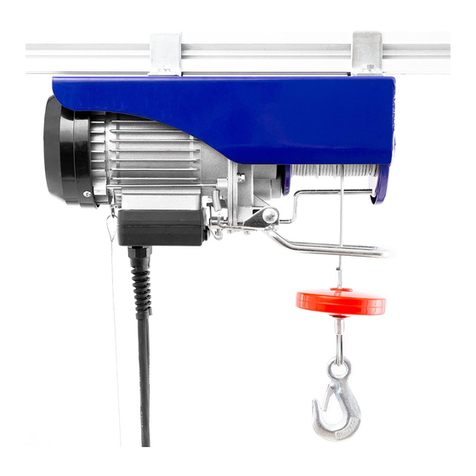
Einhell Global
Einhell Global SHZ 300-2 operating instructions

Winchmax
Winchmax WMSL13500 Fitting and Operating Guide
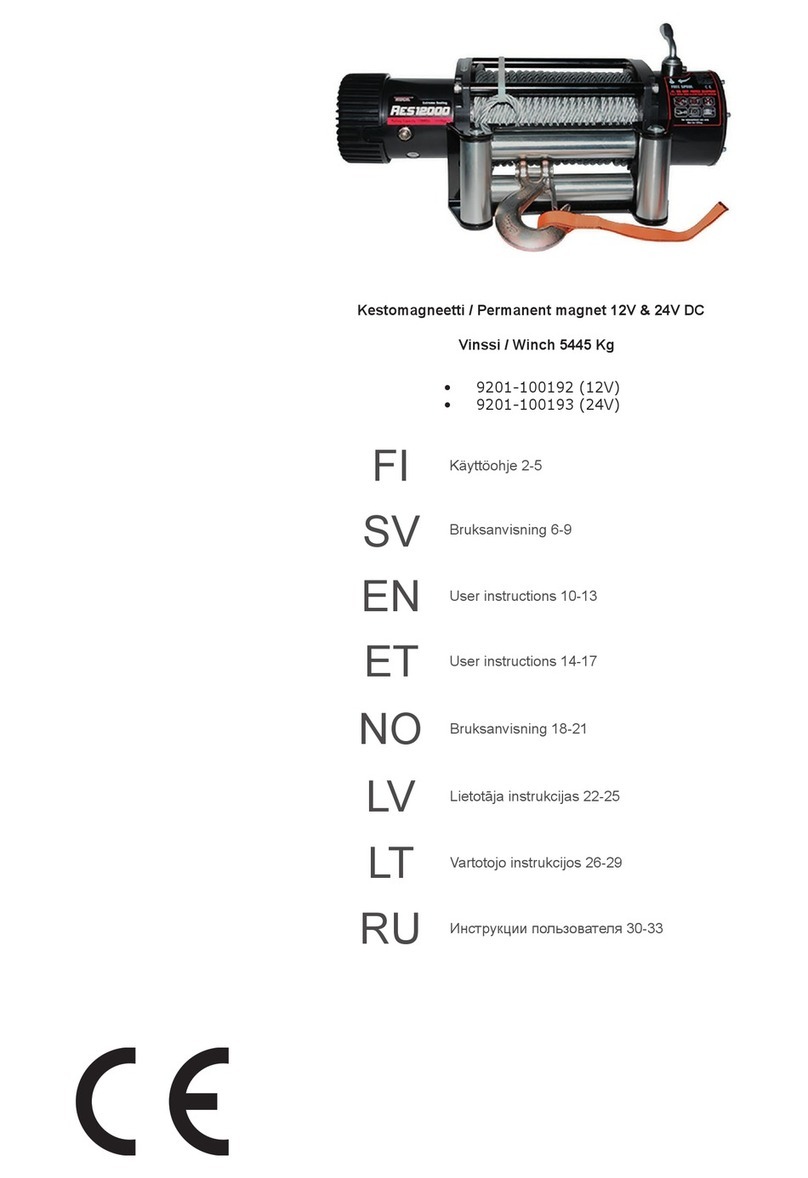
Startax
Startax 9201-100192 User instructions

Paccar Winch
Paccar Winch PA58VS INSTALLATION AND PARTS MANUAL
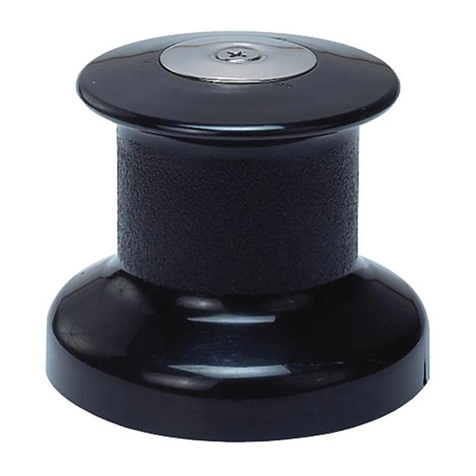
Antal
Antal W 6 Instructions For Fitting
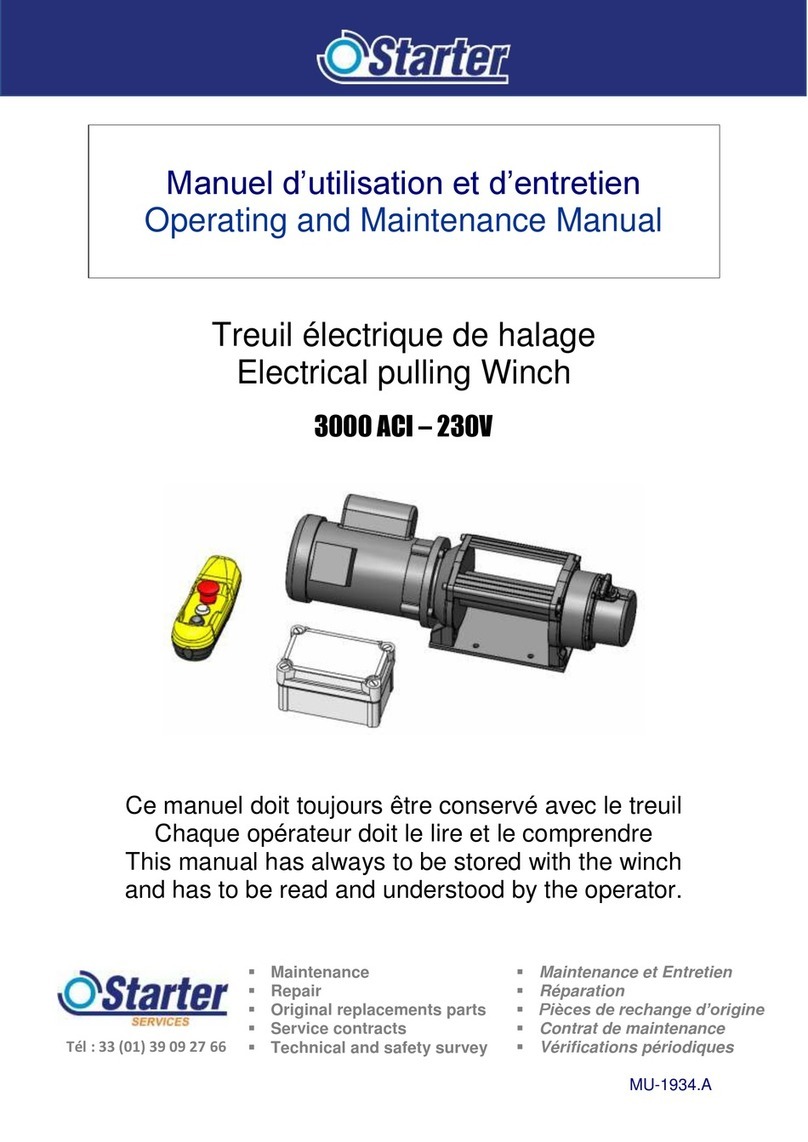
Starter
Starter 3000 ACI Operating and maintenance manual
